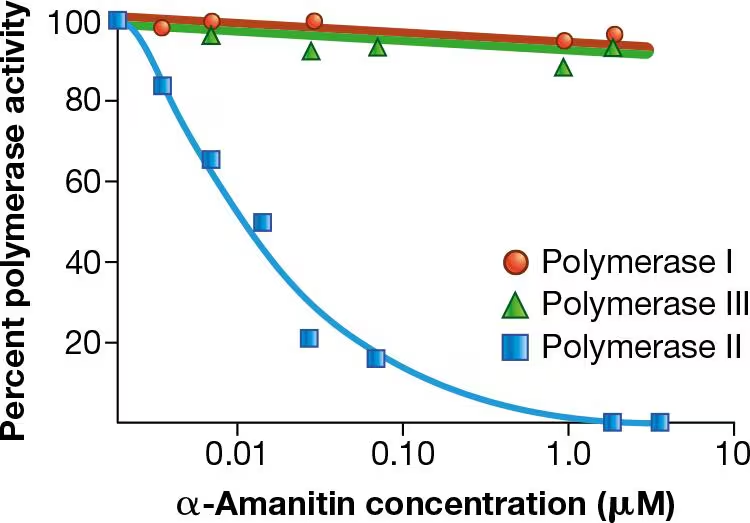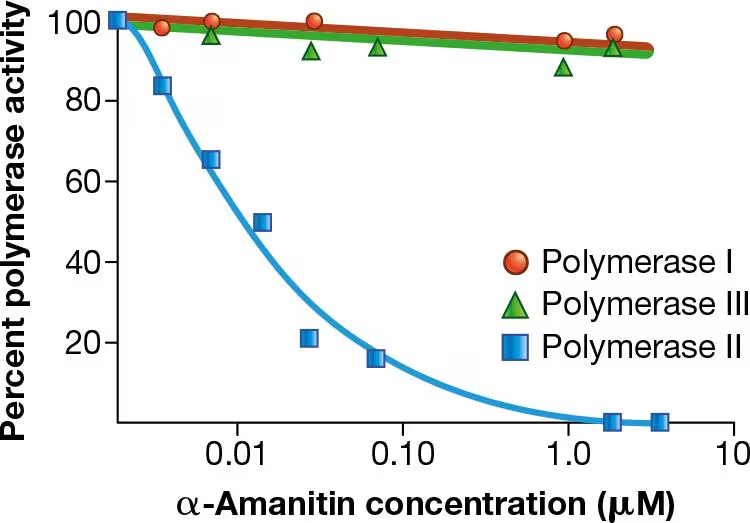 Back
BackProblem 1
What does a bacterial RNA polymerase produce when it transcribes a protein-coding gene?
a. rRNA
b. tRNA
c. mRNA
d. snRNA
Problem 2
Where is the start codon located?
a. At the start (5′ end) of the mRNA
b. In the DNA just upstream of where transcription starts
c. At the downstream end of the 5′ untranslated region (UTR)
d. At the upstream end of the 3′ untranslated region (UTR)
Problem 3
Splicing begins:
a. As transcription occurs.
b. After transcription is complete.
c. As translation occurs.
d. After translation is complete.
Problem 4
Compared with mRNAs that have a cap and tail, predict what will be observed if a eukaryotic mRNA lacked a cap and poly(A) tail.
a. The primary transcript would not be processed properly.
b. Translation would occur inefficiently.
c. Enzymes on the ribosome would add a cap and poly(A) tail.
d. tRNAs would become more resistant to degradation.
Problem 5
RNases and proteases are enzymes that destroy RNAs and proteins, respectively. Which of the following enzymes, if added to a spliceosome, would be predicted to prevent recognition of pre-mRNA regions critical for splicing?
a. An RNase specific for tRNAs
b. An RNase specific for snRNAs
c. A protease specific for initiation factors
d. A protease specific for a release factor
Problem 6
For each of these statements about the genetic code, select True or False.
a. T/F Wobble pairing accounts for the redundancy of the genetic code.
b. T/F There are 64 different tRNAs that read the 64 possible codons.
c. T/F All possible codons are used, but not all codons specify an amino acid.
d. T/F Some codons are recognized by proteins, not by tRNAs.
Problem 7
In a particular bacterial species, temperature-sensitive conditional mutations cause expression of a wild-type phenotype at one growth temperature and a mutant phenotype at another—typically higher—temperature. Imagine that when a bacterial cell carrying such a mutation is shifted from low to high growth temperatures, RNA polymerases in the process of elongation complete transcription normally, but no new transcripts can be started. The mutation in this strain most likely affects:
a. The terminator sequence
b. The start codon
c. Sigma
d. One of the polypeptides of the core RNA polymerase
Problem 8
In what ways are a promoter and a start codon similar? In what ways are they different?
Problem 9
The nucleotide shown here is called cordycepin triphosphate. It is a natural product of a fungus that is used in traditional medicines.

If cordycepin triphosphate is added to a cell-free transcription reaction, the nucleotide is added onto the growing RNA chain but then no more nucleotides can be added. Examine the structure of cordycepin and explain why it ends transcription.
Problem 10
Controlling the rates of transcription and translation is important in bacteria to avoid collisions between ribosomes and RNA polymerases. Calculate what the maximum rate of translation by a ribosome in a bacterial cell would have to be, in units of amino acids per second, so as not to overtake an RNA polymerase that is synthesizing mRNA at a rate of 60 nucleotides per second. How long would it take for this bacterial cell to translate an mRNA containing 1800 codons?
Problem 11
<Image>
Eating even a single death cap mushroom (Amanita phalloides) can be fatal due to a compound called α-amanitin, a toxin that inhibits transcription.
What would you predict to be the immediate outcome of adding α-amanitin to a cell?
a. Reduced DNA synthesis
b. Reduced production of one or more types of RNA
c. Reduced binding of tRNAs to anticodons
d. Reduced rate of translocation of ribosomes translating mRNA
Problem 12
<Image>
Eating even a single death cap mushroom (Amanita phalloides) can be fatal due to a compound called α-amanitin, a toxin that inhibits transcription.
α-Amanitin inhibits transcription by binding inside an RNA polymerase to a region other than the active site that catalyzes addition of a nucleotide to the RNA chain. Based on the model of RNA polymerase shown in Figure 17.3, predict how the toxin might function to inhibit transcription.
Problem 13
<Image>
Eating even a single death cap mushroom (Amanita phalloides) can be fatal due to a compound called α-amanitin, a toxin that inhibits transcription.
Toxins like α-amanitin are used for research in much the same way as null mutants (Chapter 16)—to disrupt a process and see what happens when it no longer works. Researchers examined the ability of α-amanitin to inhibit different RNA polymerases. They purified RNA polymerases I, II, and III from rat liver, incubated the enzymes with different concentrations of α-amanitin, and then tested their activity. The results of this experiment are shown here. These findings suggest that cells treated with α-amanitin will have a reduced level of:
a. tRNAs
b. rRNAs
c. snRNAs
d. mRNAs
Problem 14
<Image>
Eating even a single death cap mushroom (Amanita phalloides) can be fatal due to a compound called α-amanitin, a toxin that inhibits transcription.
If you wanted to use α-amanitin to shut down 95 percent of transcription by RNA polymerase II, roughly what concentration of α-amanitin would you use? Note that the scale on the x-axis of the graph in Question 13 is logarithmic rather than linear, so that each tick mark shows a tenfold higher concentration.
Problem 15
<Image>
Eating even a single death cap mushroom (Amanita phalloides) can be fatal due to a compound called α-amanitin, a toxin that inhibits transcription.
Biologists have investigated how fast pre-mRNA splicing occurs by treating cells with a toxin that blocks the production of new pre-mRNAs, then following the rate of splicing of the pre-mRNAs that were transcribed before adding the toxin. Why is addition of a toxin important in this study?
Problem 16
<Image>
Eating even a single death cap mushroom (Amanita phalloides) can be fatal due to a compound called α-amanitin, a toxin that inhibits transcription.
The primary cause of death from α-amanitin poisoning is liver failure. Suppose a physician informs you that liver cells die because their rate of protein production falls below a level needed to maintain active metabolism. Given that α-amanitin is an inhibitor of transcription, you wonder if this information is correct. Propose an experiment to determine whether the toxin also has an effect on protein synthesis.


